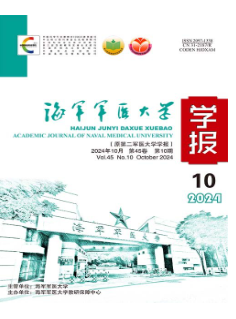2019冠状病毒病暴发期间军人恐慌状态及影响因素分析
Q4 Medicine
引用次数: 2
摘要
目的:了解2019冠状病毒病(COVID-19)流行初期军人的恐慌状态及其影响因素。在新冠肺炎疫情初期,采用整群抽样法随机抽取431名驻冀官兵,采用心理压力自评测验(PSET)、焦虑自评量表、自编新冠肺炎知识问卷、心理恐慌来源量表、各类信息发布评价量表和风险感知量表进行调查。结果显示,有5 84%(24/411)官兵处于心理应激状态,4 14%(17/411)官兵处于心理恐慌状态。心理应激状态下官兵的心理恐慌得分(47 76 + 6 51)显著高于非应激状态下官兵的心理恐慌得分(32 95 + 10 94),差异有统计学意义(t= 106 01;对新冠肺炎相关知识不同维度的了解程度差异有统计学意义(χ2=91 53, P< 0.01),对新冠肺炎相关研究进展(22 87%,94/411)和症状(20 92%,86/411)缺乏了解的比例较高,造成心理恐慌的主要来源是病毒的高传染性、所有人都戴口罩和眼镜、来自互联网的信息等。累计确诊病例数、新增确诊病例数和累计疑似病例数是关注的疫情信息,年龄、风险感知焦虑程度、感染可能性、心理应激水平和新冠肺炎知识水平是军人心理恐慌的预测因子(P< 0.05或P< 0.01)。军人对新冠肺炎恐惧的预测因子包括新冠肺炎对个人和社会的影响、新冠肺炎事件特征(P< 0.05或P< 0.01)。对于恐慌状态的干预,最需要提供相关的医学知识。在新冠肺炎疫情早期,风险认知、心理恐慌来源等因素会影响军人的心理恐慌。在新冠肺炎疫情期间,应采取相应措施防止官兵的心理恐慌本文章由计算机程序翻译,如有差异,请以英文原文为准。
Panic state and related influencing factors among military personnel during coronavirus disease 2019 outbreak
Objective: To explore the panic state and related influencing factors among military personnel during the early epidemic stage of coronavirus disease 2019 (COVID-19) Methods: In the early stage of the COVID-19 epidemic, 431 officers and soldiers stationed in Hebei were randomly selected by the cluster sampling method and investigated with psychological stress self-evaluation test (PSET), self-rating anxiety scale, and self-designed questionnaires regarding the knowledge of COVID-19, sources of psychological panic scale, evaluation scale of various information released and risk perception scale Results: A total of 411 valid questionnaires were collected, with an effective rate of 95 36% The results showed that 5 84% (24/411) of the officers and soldiers were in psychological stress state and 4 14% (17/411) in psychological panic state The psychological panic score of officers and soldiers in psychological stress state (47 76 + 6 51) was significantly higher than that in non-stress state (32 95 + 10 94), and the difference was statistically significant (t= 106 01, P< 0 01) There were significant differences in their understanding of different dimensions of COVID-19 knowledge (χ2=91 53, P<0 01) The high proportions of lack of understanding were found for COVID-19 related research progress (22 87%, 94/411) and symptoms (20 92%, 86/411) The main sources of psychological panic were the highly infectious trait of the virus, all wearing masks and eye glasses, information from the Internet and so on Among all kinds of released information, the numbers of cumulative confirmed cases, new confirmed cases and cumulative suspected cases were the concerned epidemic information The age, degree of anxiety in risk perception, possibility of infection, level of psychological stress and knowledge regarding COVID-19 were the predictors of psychological panic among military personnel (P<0 05 or P< 0 01) Among the dimensions of risk perception, the predictors for apprehension regarding COVID-19 among military personnel included the influence of COVID-19 on individuals and society and event characteristics of COVID-19 (P<0 05 or P<0 01) For the interventions of panic state, providing relevant medical knowledge was the most needed Conclusion: During the early stage of COVID-19 epidemic, factors such as risk perception and the sources of psychological panic can affect the psychological panic among military personnel During the CVOID-19 epidemic, corresponding measures should be taken to prevent the psychological panic among the officers and soldiers
求助全文
通过发布文献求助,成功后即可免费获取论文全文。
去求助
来源期刊

海军军医大学学报
Medicine-Medicine (all)
CiteScore
0.50
自引率
0.00%
发文量
14752
期刊介绍:
Founded in 1980, Academic Journal of Second Military Medical University(AJSMMU) is sponsored by Second Military Medical University, a well-known medical university in China. AJSMMU is a peer-reviewed biomedical journal,published in Chinese with English abstracts.The journal aims to showcase outstanding research articles from all areas of biology and medicine,including basic medicine(such as biochemistry, microbiology, molecular biology, genetics, etc.),clinical medicine,public health and epidemiology, military medicine,pharmacology and Traditional Chinese Medicine),to publish significant case report, and to provide both perspectives on personal experiences in medicine and reviews of the current state of biology and medicine.
 求助内容:
求助内容: 应助结果提醒方式:
应助结果提醒方式:


